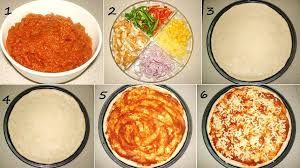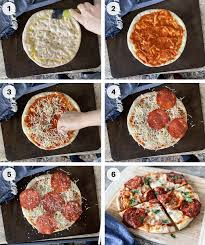How To Make Good Pizza topping In 2023
How To Make Good Pizza topping In 2023
There are some variations to this, of course: Chicago’s “deep dish” pizza, for example, reverses the order by covering thick layers of sausage and cheese with a final topping of sauce before baking. While this arrangement makes for a uniquely decadent pizza, it won’t result in the crispy, crunchy Neapolitan-style pizza that everyone loves.Everyone knows the classic pizza arrangement of crust, sauce, cheese, and then toppings—but why exactly is this order the standard, and when can you mix things up?
While you can arrange your pizza any way you’d like, especially with the right pizza oven, the classic pizza arrangement is still a classic for a reason: In most cases, toppings need the most cooking and direct heat, while sauce and cheese only need just enough heat to warm them through. As a result, the classic order of “toppings on top” ensures that every ingredient gets just the right amount of heat.
It’s also a good idea to keep cheese, sauce, and other “melty” ingredients below the uppermost layer of toppings since they might otherwise prevent other ingredients from cooking through completely. To further guarantee the best homemade pizza, check out the infographic below or visit Fontana Forni.
While sauce and cheese should almost always go on the bottom, it’s typically the toppings themselves that require the most attention. No matter how many layers your pizza has, the top-most layer will receive the most heat. As a result, the general rule is to give the toppings that need the most cooking and browning—such as raw meat or vegetables—the most surface area on top of the pizza.
When you’re preparing your pizza you’ve probably wondered which order your tomato, cheese, and toppings should go. Sometimes this is actually a hotly debated topic depending on where you are in the world.
Typically tomato sauce will go on first on top of the dough, then cheese, and then toppings. This allows the cheese to bubble and brown and the toppings to get direct heat and become crisp. There are some exceptions where the cheese is put first, or the toppings are put under the cheese but these are only certain pizzas.
So should you put the cheese or tomato first? Do you put toppings or cheese on pizza first? When making pizza what goes on first?
Let’s discuss why this is and what are the exceptions. I’ve got some instructions on how to properly top a pizza too.
Top The Pizza In This Way
Presentation is also important. By adding the toppings last then you can easily see what is on the pizza and makes it look appetizing. This wouldn’t be the same if you buried the pizza toppings under the cheese.
Probably the most important is the texture and flavor which is improved with the right order. With the cheese and toppings in direct heat, they get toasted the most.
Cheese that has been toasted gets a deeper flavor and crispy texture. No one wants raw, mushy cheese on pizza.
Pizza just looks better when the
toppings are over the cheese. You can easily identify what is on the
pizza and the eye-catching colors of the toppings will make the pizza
look very appetizing.
In addition to just looking better, having pizza toppings on top of the cheese can prevent the toppings from getting soggy and mushy. If the toppings go under the cheese, they will be steamed and rapidly cooked when the pizza goes into the oven.
The heat from the oven will cause the toppings to release water vapor as they cook. This water vapor will get trapped under the cheese, causing the toppings to steam themselves.
If you put pineapples under the cheese, you will get pineapple mush. If you put pepperoni under the cheese, you may have some soggy pepperoni on your pizza. Many pizza toppings should not be steamed.
So, if you want to avoid mushy toppings, keep them on top of the cheese when they can cook and crisp in the oven.
My best tip for making pizza in a home oven is to use a pizza “steel”. It adds intense heat from below for amazing crusts – I have this steel from Amazon which is much lower priced than other brands but works perfectly. Steel conducts heat better than stone, they don’t shatter and are easier to clean.
If it’s out of your price range then the 2nd best option is a pizza stone made from cordierite. To see a round-up of the most important pizza equipment check out my essential pizza equipment list
Lastly, the order comes down to ease of use. It is much easier to spread the liquid tomato sauce on a blank pizza base rather than spread it evenly over cheese and toppings. So you can get a nice even layer of tomato
Problems in this order
The main problem you can get by adding wet tomato sauce directly onto the pizza dough is a soggy pizza base. The dough will absorb water and become less crisp in the oven.
To avoid this you can make a waterproof barrier by using sliced cheese on the base first. On top of this, you put your layer of tomato sauce (easier to apply on cheese slices) and then toppings.
You don’t get the advantage of toasted cheese on the pizza topping, but you can add some grated Pecorino or Parmesan when it comes out of the oven for a great finish.
Where pizza Cheese Goes On First?
There are several pizzas that have the cheese on first. Sicilian-style pizzas put the cheese directly on the pizza crust and then the sauce goes on top.
This style is common in Jamaica , New York tomato pie, as well as many other parts of the USA.The idea behind this method is that the crust cooks better without the wet sauce directly on it. The Sicilian pizza is deeper and cooked in a tray, almost like a Focaccia with toppings on. It is traditional to put the cheese on first. This helps the thick bread-like dough underneath not become soggy.
Where Should Toppings pizza Go?
The main thing to think about when deciding when to put toppings on a pizza is how the toppings will hold up in the oven.Unfortunately, the answer is a little more complex than you may have thought and it all revolves around what toppings you are choosing to put on your pizza.
When you bake a pizza, you use a very hot, dry oven which can cook food very quickly. This high heat will have a great effect on your toppings, especially if they are placed on top of the cheese.If you have ingredients that are very sensitive to hot, dry temperatures, you will want to bury them under the cheese on the pizza, protecting them from the oven heat.
Think about it this way – if you put your favorite pizza topping on a sheet tray all by itself and placed it in the oven, what would happen? Would it burn quickly? Would it get dry and crunchy? Or would it stay soft and tender, allowing the oven to enhance its taste?
So, as a general rule, consider if your toppings will become dry and
crisp when exposed to the hot oven. If so, they should be buried under
the cheese. If the toppings will hold up well to the heat, put them
right on top of that cheese!
The answers to this question will determine when to put the topping on the pizza. Toppings that will get dry and burn, hide under the cheese. Pizza toppings that benefit from heat, keep on top of the cheese.
Of course, you can cook the toppings first, separately from the pizza, and give them some moisture and resistance to the heat. If you do this extra step, they can definitely go right on top of the cheese.
How To check A Pizza Properly
Start with my pizza dough recipe which is a great all-round dough.
1. Stretch out your dough on a flat worktop with some flour and semolina. Using your hands is better than a rolling pin.
You can turn and stretch outwards on the worktop or pick it up and help gravity stretch it over your fists. Place it on top of your peel with some flour.
2. Add your sauce in a circular motion. Then add your cheese and then the toppings. You don’t need too many toppings when cooking fresh dough, so don’t overload it.
Be careful not to get sauce on the peel as the moisture will make the dough stick. Periodically give it a small shake to make sure it hasn’t stuck.
3. Open the oven and transfer the pizza to the stone with a swift back-and-forth wrist action to drop the pizza on the stone. Think of it like the magic trick with the tablecloth – pulling back quickly and confidently.
Try not to angle the peel down too much otherwise the edge of the dough will get caught on the hot stone, and your toppings will fall off.If you don’t have a pizza peel then check out my article on the best pizza peels to make sure you get a good one that suits your oven.Conclusion
While it is typically best to put the tomato sauce before the cheese, and the toppings on your pizza on top of the cheese, there are a few exceptions to this rule as you have just seen.Consider the effect the dry oven will have on the toppings in order to decide if they should be tucked under the cheese or piled up high on top. After making a few pizzas covered in toppings, you will surely be a pizza topping expert.
You should also give the Sicilian-style pizza a go and put the cheese on the base first. This pizza is one of my favorites and is great when cooking for a crowd.
For a guide of all the best tools to help you make better pizza at home and where to get them, check out my article.










